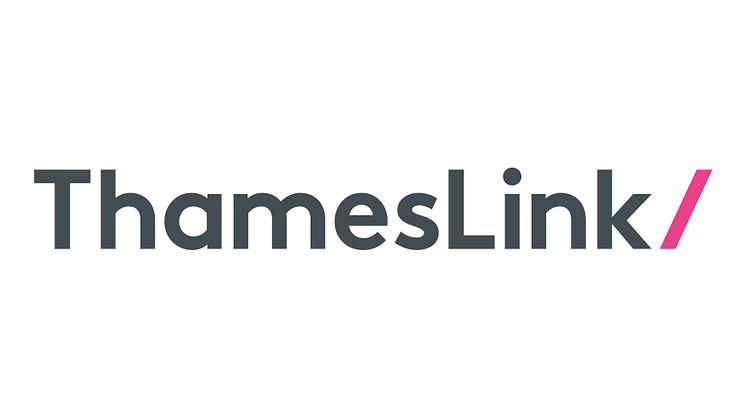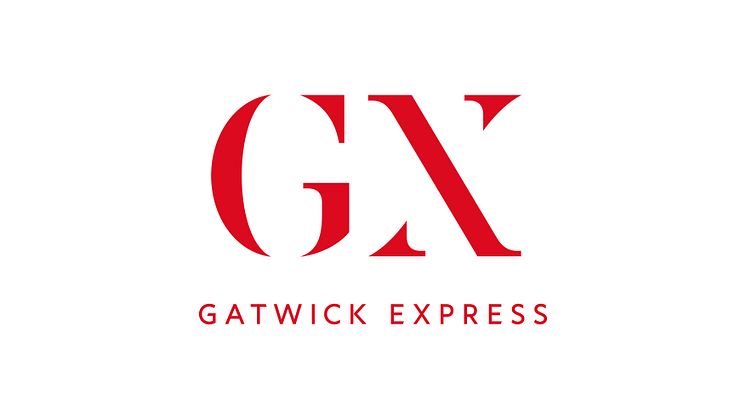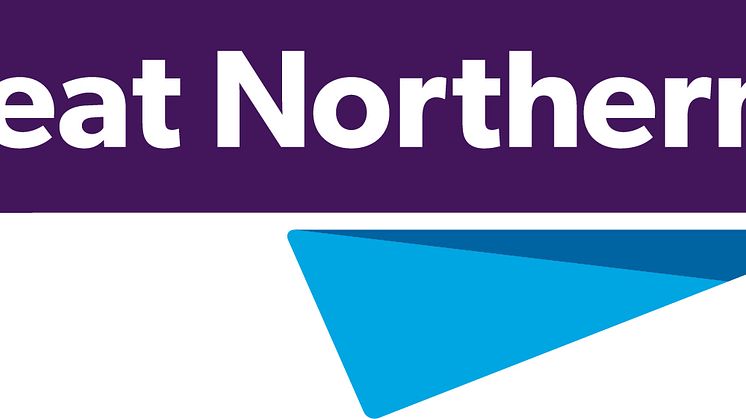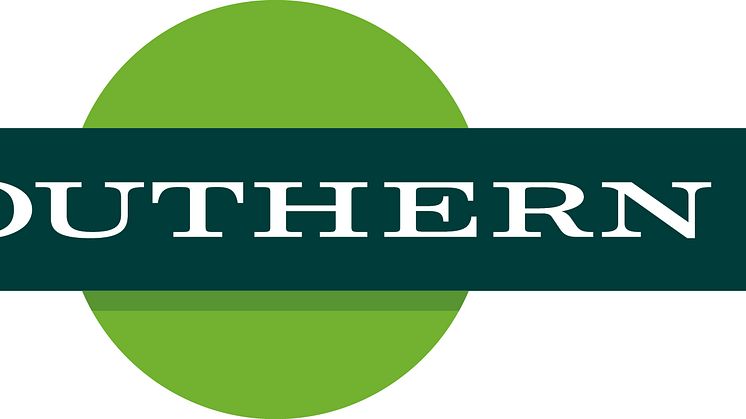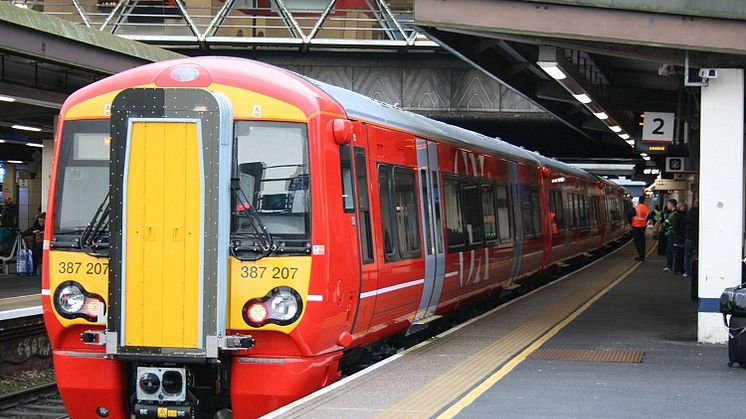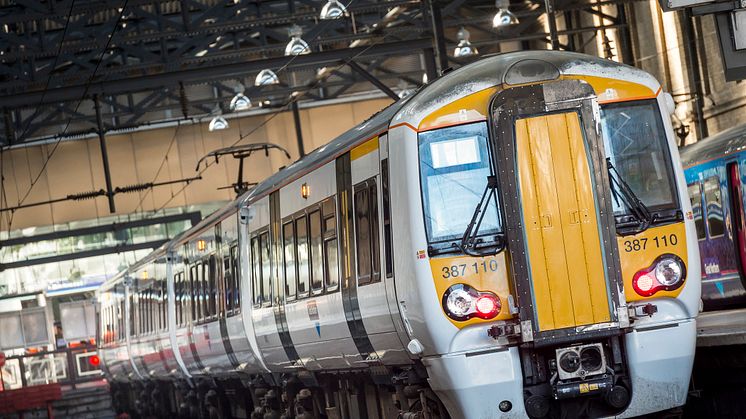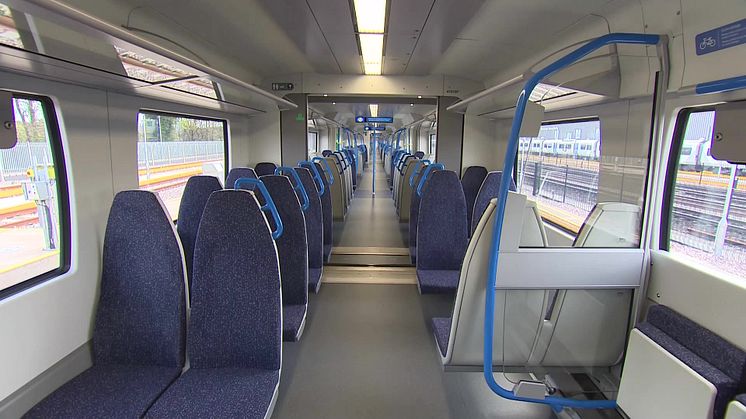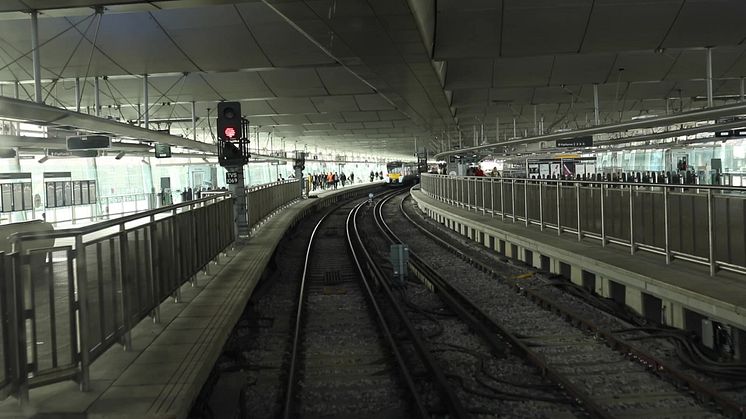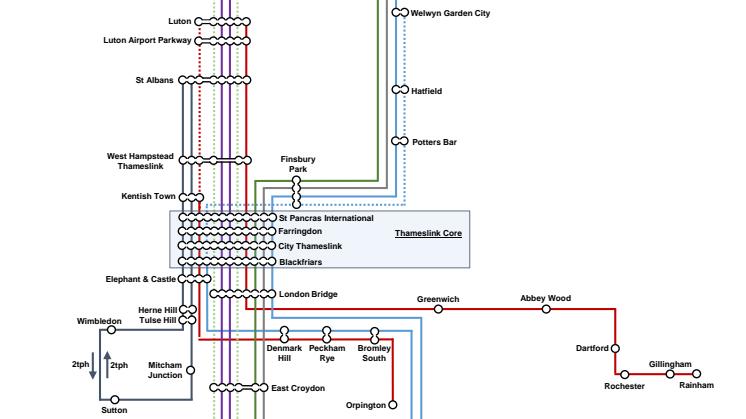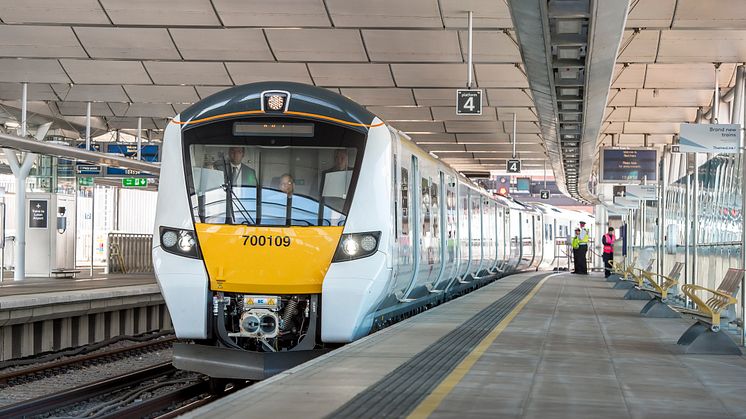
Press release -
GTR announces biggest ever timetable shake-up in major advance for rail expansion
EMBARGOED to 10.00 HOURS 24 APRIL 2018
Govia Thameslink Railway (GTR) today advised passengers to plan ahead for the biggest timetable shake-up in UK rail history in a month’s time.
As the UK’s largest rail franchise, GTR has published the new details of train services that will affect almost a million rail journeys a day in the southern half of the UK.
GTR runs up to 3,200 trains a day – one every 27 seconds – and the times of all of these will change under the improved timetable.
The new schedule will operate from 02.00 on Sunday 20 May across the GTR network from as far afield as Cambridge and Peterborough to Brighton and Southampton.
Space for 40,000 more passengers into London at peak times will be added next month, a weekly capacity boost equivalent to the population of Bristol.
Major upgrades have been introduced as the GTR network, comprising Thameslink, Great Northern, Southern and Gatwick Express is the UK’s most congested railway with passenger numbers doubling in 12 years on some parts.
GTR passengers will benefit from more frequent services and, by next year, 80 more stations will have direct services to central London stations such as Farringdon, City Thameslink and Blackfriars.
Expansion of service is a major step forward in the Government-sponsored £7bn Thameslink Programme, the upgrade project which includes the recently-completed £1bn upgrade of London Bridge station by Network Rail.
Over more than a decade, platforms have been extended, stations rebuilt, and power supplies boosted for longer trains. Signalling has been upgraded and track reworked to improve reliability and allow trains to travel at high-frequency through central London in “self-drive” mode. GTR has also undertaken the UK’s biggest driver recruitment and training campaign.
Charles Horton, GTR Chief Executive, said: “A huge number of passengers will notice the benefits in terms of new journeys, better intervals between trains, improved reliability, and more capacity across a wide region.
“We are redeploying trains and crew and there may be some disruption, so we ask passengers for their understanding during the transition period of several weeks during which time a very small number of trains will not run.
“Almost a quarter of all rail journeys are taken on the GTR network and because of the necessary scale of the change we strongly urge passengers to check ahead as to how their journeys will be affected.
“Introduction of the new timetables is a major milestone in the delivery of RailPlan 20/20, our programme to modernise rail services, taking advantage of the new infrastructure and trains provided by the Thameslink Programme.
“These changes followed the biggest and most effective consultation of its kind during which we made hundreds of amendments, some substantial, in response to 28,000 responses.”
ends
Editor’s notes
There are approx. 900,000 journeys made each day on GTR
The new timetables have been published at https://www.railplan2020.com/timetables
General highlights of the new services include:
- New trains and services, creating capacity for approximately 40,000 more peak-time passengers from May this year to London from Kent, Sussex, Surrey, Bedfordshire, Hertfordshire, Cambridgeshire and Peterborough combined, rising to 60,000 in 2019
- Thameslink trains will run from 80 more stations by December 2019 (140 in total) so passengers will no longer have to change if they are travelling to St Pancras International, Farringdon, City Thameslink and Blackfriars in central London. Most of this improved service starts this May
- The £1bn Thameslink Programme upgrade to London Bridge has been a key factor in this extension of services and trains from most stations will call there
- There will be up to 24 trains an hour and 70% increase in peak time seats between London Blackfriars and St Pancras International
- The expanded Thameslink network means fewer passengers will need to switch to the Tube to complete their journey, saving time and money on their daily commute
- Eventually, passengers from all 140 Thameslink stations will be able to travel directly to the Elizabeth line services (Crossrail) at Farringdon, that begins in December 2018
- Journeys to Canary Wharf and Paddington via the Elizabeth Line (Crossrail) at Farringdon will be 10-15 minutes quicker
- International travel from many stations will also improve, with quicker rail journeys to Gatwick, Luton and Heathrow airports and St Pancras International for Eurostar
- To carry even more passengers, Thameslink is introducing 115 new trains, many capable of carrying as many people as 21 double decker buses
- Passengers on Southern Railway will benefit from improved reliability when a completely new timetable is introduced in May. This will not only dovetail with the new Thameslink service but also fix many issues that have been delaying trains
- More spacious trains: 115 new Thameslink trains, many big enough to carry as many people as 21 double-decker buses.
Thameslink – detailed improvements
- A massively expanded network with, by the end of 2019, cross-London Thameslink trains calling at 80 more stations
- A significant increase in frequency and length of trains between Bedford and St Pancras: Bedford 32% more carriages, 33% more seats; Luton 27% more carriages, 25% more seats; St Albans 30% more carriages, 25% more seats (year on year)
- Thameslink services diverted via Crystal Palace start to call again at London Bridge (saving up to 15 minutes on journeys south of Blackfriars)
- New half-hourly cross-London service from Horsham via Redhill to London Bridge, Blackfriars, Farringdon, City Thameslink, St Pancras International and beyond to Stevenage and Peterborough
- New half-hourly cross-London service from Gatwick Airport via Redhill to London Bridge, Blackfriars, Farringdon, City Thameslink, St Pancras International and beyond to St Albans, Luton Airport Parkway, Luton and Bedford
- Littlehampton via Hove to London Bridge peak services transfer to Thameslink, with a new timetable and cross-London travel opportunities to London Bridge, Blackfriars, Farringdon, City Thameslink, St Pancras International and beyond to St Albans, Luton Airport Parkway, Luton and Bedford
- New half-hourly peak-time cross-London service from East Grinstead via Oxted to London Bridge, Blackfriars, Farringdon, City Thameslink, St Pancras International and beyond to St Albans, Luton Airport Parkway, Luton and Bedford
- At Brighton – 15 trains to London Bridge in the morning peak compared with 5 today
- Anyone travelling from East Croydon to London Bridge (and onward interchange) will see a significant uplift in services – four times the number of services to Blackfriars in the morning rush
- New Thameslink services for Greenwich, Dartford and the Medway towns between Luton and Rainham (north Kent)
- Radlett, Elstree & Borehamwood and Mill Hill Broadway will benefit from improved off peak services – up to 6 per hour
- Catford Loop in south London – doubling of off-peak services to London, bringing extra capacity to Denmark Hill, Peckham Rye, Nunhead, Crofton Park, Catford, Bellingham, Beckenham Hill and Ravensbourne
- An improved half-hourly overnight train service will be introduced between Bedford and Three Bridges serving Luton and Gatwick Airport
Great Northern – detailed improvements
- Direct Thameslink services from Cambridge and local Great Northern stations to Brighton via London Bridge and Gatwick Airport will offer new destinations and travel opportunities
- By the time the programme is complete almost twice as many carriages from Cambridge and almost double the number of standard class seats – 4,600 more vs 5,000 with over 2,000 more additional fast service seats
- Direct Thameslink services from Peterborough to Horsham via London Bridge and Gatwick Airport
- By the time the programme is complete almost a third more carriages from Peterborough, Huntingdon, St Neots with over 1,200 more seats (over 20% more) (base: all services).
- Increased frequency and capacity of trains from Welwyn Garden City.
- Hadley Wood will enjoy increased off-peak frequency into London after extensive consultation with passenger groups
- Increased off peak services on the Hertford Loop (4 trains per hour up from 3 trains per hour and doubling on Saturdays from 2 trains per hour to 4 trains per hour)
- Increased off peak services between Moorgate and Welwyn Garden City (4 trains per hour up from 3 trains per hour and doubling on Saturdays and Sundays)
- Improved frequency for Watton at Stone (increased to half hourly)
- Trains between London Kings Cross and Kings Lynn will now serve Cambridge North
- Improved evening services between London and Hitchin, Letchworth and Baldock
- Changes to calling patterns for Royston and Letchworth to better match demand
Southern – detailed improvements
- Over 50% longer trains (from 5 carriages to 8) throughout the day on the West London Line between East Croydon and more frequent services to and from Watford Junction in the morning and evening peaks to provide much-needed additional capacity (many people at stations from Norbury and Streatham Common change onto these services at Clapham Junction)
- A new South London Metro network featuring longer trains in the off-peak with better, faster services for most of the day:
- Improved all-day services between Epsom and London Bridge
- Improved peak trains between Mole Valley (Dorking) and London Bridge with four trains in the morning and evening peak (currently one morning peak train)
- Doubling of the off-peak frequency and a new Sunday services between Sutton, Belmont, Banstead and Epsom Downs
- Direct trains between Peckham Rye, Tulse Hill, Streatham and East Croydon, Purley and Caterham
- Improved peak service between Tulse Hill, Peckham Rye and London Bridge – 6 trains per hour introduced
- Improved off peak service for Reedham and Coulsdon Town
- Faster all-day services between Caterham, Tattenham Corner and London Bridge with all trains formed of 10 carriage trains
- Improved evening services on many routes
- Significant improvements are being made to our East Coastway route:
- Improved morning peak mainline services from Eastbourne to London Victoria with three additional peak arrivals at 0705, 0735 and 0754 filling an existing two-hour gap.
- The first train to London Victoria from Eastbourne will depart 20 minutes earlier providing an earlier arrival into Gatwick Airport.
- An improved half hourly evening peak train will be introduced between London Victoria and Eastbourne with an additional train at 1815 reducing two 45-minute gaps
- Increased frequency (6 trains per hour instead of 5 trains per hour) between Brighton and Lewes with increased stops at Falmer and Moulsecoomb
- Increased frequency (4 trains per hour instead of 3 trains per hour) between Eastbourne and Hastings
- Improved all-day service every 30 minutes and faster journeys for some trains between Brighton and Hastings
- We are doubling the length of most trains along the most popular sections of our east coast route, between Brighton and Hastings (especially busy in the summer). We’re also increasing the frequency of services by a third between Eastbourne and Hastings. Trains will also connect better with the high-speed services at Ashford International, saving passengers time, for example a 99-minute journey time from Bexhill to St Pancras changing at Ashford International.
- Improved connections with Southeastern High Speed services at Ashford International for Ebsfleet International and London St Pancras International
- New late evening train one hour later than current, from Ashford International to Hastings via Rye
- New later weekday, later evening and Sunday services for Normans Bay
- An earlier first and later last train from East Grinstead to London Victoria will be introduced on weekdays and Saturdays and on Sundays the half hourly frequency will be extended for more of the day.
- An additional evening peak train will be introduced from London Bridge to Uckfield on weekdays and earlier Sunday morning trains will be introduced on the Uckfield route
- Reigate will see an improved peak and all-day train service – a half hourly train service will be introduced featuring direct evening services and new Sunday service for the first time.
- A new all-day train service will be introduced from Merstham, Coulsdon South and Purley to London Victoria
- On the West Coastway route, additional peak trains to London will be introduced
How the timetable has been developed
The timetable has been developed from a ‘blank sheet of paper’, analysing issues and conflicts.
With passenger numbers doubling in 16 years (in just 12 years on much of Southern), the allocated stop times at many stations are simply too short to reasonably account for those getting off and on - so at 75 stations trains will stop for longer
Many services currently have very short turnaround times at destination stations, so the slightest delay on the route means they don’t start their return journey on time and the delay multiplies – the new timetable has increased turnaround times to help
The new timetable removes the vast majority of splitting and attaching of trains now required at terminus stations such as London Bridge and London Victoria. Many trains will be kept in fixed formation instead. This means services won’t have to wait for other sections of train to arrive and couple up and will travel at their full length throughout the day.
Trains and train crew currently travel on different lines during the day which means that, if there are delays, this can mushroom and affect more than one line. The new timetable endeavours to keep trains and crew on dedicated routes throughout the day.
Transition period
On most routes, the new timetable will operate in its entirety from Sunday 20 May. However, on some, a limited number of individual existing services will not run at the beginning – one or two in each weekday peak* and some in the off-peak. This will steadily reduce in number as trains are moved into place. The full service will run across all routes from 11 June.
The routes where services are reduced are:
- Peterborough - London: 2 trains in each peak (1 for 2 weeks, 1 for a single week)
- Luton - London: 1 train in the morning peak (for 1 week), 2 trains in the evening peak (1 for 1 week and one for 3 weeks)
- Rainham - London: 1 train in the morning peak (for 2 weeks); 1 train in the evening peak (for 3 weeks)
- Orpington - London: There are no trains affected in the peak, only off-peak
- Horsham - London: There are no trains affected in the peak, only off-peak
* The peak is defined as trains arriving in London between 0700 and 0959 and departing London between 1600 and 1859.
Topics
Categories
Govia Thameslink Railway
Govia Thameslink Railway (GTR) operates Thameslink, Great Northern, Southern and Gatwick Express services as follows:
- Thameslink – services between Bedford and Brighton, Luton/St Albans and Sutton, Wimbledon and Sevenoaks
- Great Northern – services between London and Welwyn, Hertford, Peterborough, Cambridge and King’s Lynn
- Southern – services between London and the Sussex coast (Brighton, Worthing, Eastbourne, Bognor Regis, Hastings) and parts of Surrey, Kent and Hampshire (Ashford International, Southampton, Portsmouth)
- Gatwick Express – fast, non-stop direct services between Gatwick Airport and London Victoria
www.southernrailway.com, www.thameslinkrailway.com, www.gatwickexpress.com, www.greatnorthernrail.com

